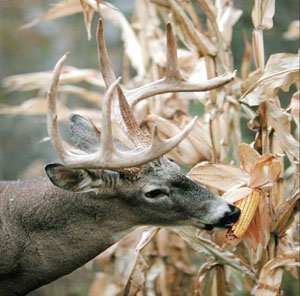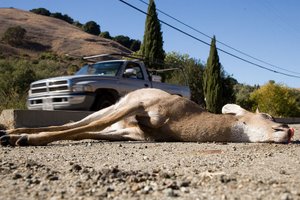
As hunters, we know how expensive it’s becoming to hunt white-tailed deer. Not only are the prices of guided hunts and hunting leases going up, but the price of raw land is rapidly rising, as well. To make matters worse, deer managers are being hit with the climbing costs of food plot seeds, supplemental feeds, and vehicle and tractor fuels.
And as much money as the hunting industry may bring in to the US economy, it’s only a portion of the total economic impact white-tailed deer have in this country. A recent and conservative estimate put a $12.5 million price tag on deer-vehicle collisions in the state of Texas alone!
But what about crop damage? And damage to ornamental plants? And loss of human life? I understand that in many cases problems arise as people move into areas inhabited by deer. However, many suburbs create their own problems through feeding and the prohibition of hunting. But problems are problems regardless of how they come about.
We talk a lot about deer hunting and management, but let’s look at some economic aspects concerning white-tailed deer that are not related to hunting.
A recent survey of US farmers revealed that as many as 56% believed they had suffered crop damage by wildlife — and deer were the primary culprit. Farmers in Pennsylvania estimated $30 million in annual crop damage; Wisconsin estimates it’s farmers are hit for another $37 million a year.
Although I don’t have any substantial data, it seems evident that suburban home owners spend millions of dollars on replacing landscaping plants defoliated or damaged by deer. High suburban deer densities not only create plant damage and loss, but spur millions in spending on exclusion devices such as fencing.
From a study conducted in 1995, conservative estimates place deer-car collisions in the US at over 500,000 accidents annually. Due to these deer-related accidents, vehicle damage was estimated in the hundreds of millions of dollars — and that was in 1995! The annual damage in New Jersey alone is estimated to exceed $10 million dollars.
In Pennsylvania, a state that tracks deer-vehicle collisions, there are currently over 40,000 deer-vehicle collisions annually and conservative estimates put damage at $25 million.
Even more important is the cost in human life. During the 1985-1994 period, 12 fatalities were reported as a result of deer-vehicle collisions in Virginia alone.
And to me, all this seems just a bit ironic. Hunters fund the bulk of wildlife management through license sales and taxes on guns, ammo, and other outdoor gear. We spend tons of time and money chasing these animals, spending days sweating it out in the south or freezing our butts off in the north, just hoping to see something and maybe even get a shot off.
But then John and Jane Doe gets upset when a deer eats their oak sapling or crashes through the grill of their SUV. What a waste.

What a crock, you are the one creating this deer large herd. Tearing down trees, burning vegetation, “proctecting” fawns all so you can have your abundance of deer for “sports”. If we did not have wildlife killing and only wildlife watching, so much money would not be wasted on “creating” this large deer to kill for “sports” because wildlife watching the animals are not killed for trophy, so there is no need to spend millions of dollars manipulating habitat to replace them. With wildlife watching the deer is alive and will always will be alive but with you they are dead. Then with deer vehicle accident you cost more on state money and of course human suffering.
So much hypocrisy and contradition with the wildlife killing public.
Caroline TC, thanks for visiting the site and thanks for your comment. You have a very narrow focus because although the habitat management practices do help deer populations thrive, they also help many other game and non-game populations do better. The fees from hunting and fishing licenses, as well as from taxes on outdoor products, pay for the management of game and non-game populations and many of the state parks.
Also, even without deer hunting, deer will not always be alive. Time for a reality check.